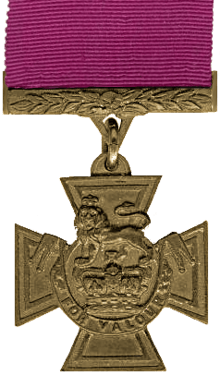Dudley Graham Johnson
| Dudley Johnson | |
|---|---|
 | |
| Born |
13 February 1884 Bourton-on-the-Water, Gloucestershire |
| Died |
21 December 1975 (aged 91) Fleet, Hampshire |
| Buried at | Christ Church Churchyard, Church Crookham |
| Allegiance | United Kingdom |
| Service/branch | British Army |
| Years of service | 1901–1944 |
| Rank | Major General |
| Commands held |
2nd Battalion North Staffordshire Regiment 4th Division Aldershot Command |
| Battles/wars |
Second Boer War First World War Second World War |
| Awards |
Victoria Cross Companion of the Order of the Bath Distinguished Service Order & Bar Military Cross Mentioned in Despatches |
Major General Dudley Graham Johnson VC, CB, DSO & Bar, MC (13 February 1884 – 21 December 1975) was a British Army officer and an English recipient of the Victoria Cross, the highest award for gallantry in the face of the enemy that can be awarded to British and Commonwealth forces.
Military career
Johnson served with the Wiltshire Regiment in the Second Boer War.[1] He transferred to The South Wales Borderers in 1903.
He was 34 years old, and an acting lieutenant colonel in The South Wales Borderers, British Army, commanding 2nd Battalion, The Royal Sussex Regiment during the First World War when the following deed took place at the Sambre Canal, France for which he was awarded the VC.
On 4 November 1918 at Sambre Canal, France, the 2nd Infantry Brigade, of which the 2nd Battalion, The Royal Sussex Regiment formed part, was ordered to cross by the lock south of Catillon. The position was strong and the assaulting and bridging parties were halted on arrival at the waterway 100 yards from the canal by a heavy barrage. At this point Lieutenant-Colonel Johnson arrived and personally led an assault but heavy fire again broke up the attack. He reorganized the assaulting and bridging parties and this time effected a crossing but the success of this dangerous operation was entirely due to his splendid leadership.[2][3]
Between the wars he held a number of instruction and staff posts before being appointed Commanding Officer of 2nd Bn North Staffordshire Regiment in 1928.[1] He became Commander of 12th (Secunderbad) Infantry Brigade in 1933 and General Officer Commanding 4th Division from 1938 to 1940.[1] He was replaced as divisional commander after Dunkirk and made GOC of Aldershot Command later on in 1940 before becoming Inspector of Infantry in 1941.[1] He retired in 1944 and was Colonel of the South Wales Borderers from 1944 to 1949.[1]
His Victoria Cross is displayed at the South Wales Borderers Museum, Brecon, Powys, Wales.
Family
He was married to Marjorie Grisewood, who died in 1950. They had one son and two daughters.
References
- 1 2 3 4 5 Liddell Hart Centre for Military Archives
- ↑ The London Gazette: (Supplement) no. 31108. p. 305. 3 January 1919. Retrieved 4 April 2015.
- ↑ Battlefields
Further reading
- Monuments to Courage (David Harvey, 1999)
- The Register of the Victoria Cross (This England, 1997)
- VCs of the First World War - The Final Days 1918 (Gerald Gliddon, 2000)
- Biographical Dictionary of British Generals of the Second World War, Nick Smart. ISBN 1-84415-049-6.
External links
- Location of grave and VC medal (Hampshire)
| Military offices | ||
|---|---|---|
| Preceded by Clive Liddell |
General Officer Commanding the 4th Division 1938–1940 |
Succeeded by Ralph Eastwood |
| Preceded by Sir Geoffrey Raikes |
GOC-in-C Aldershot Command 1940–1941 |
Succeeded by Post disbanded |